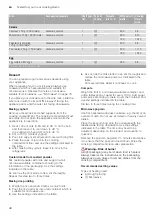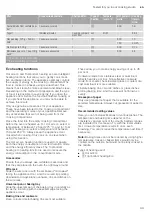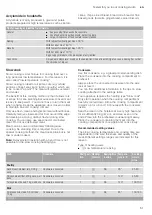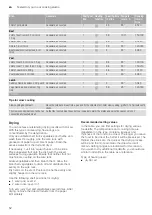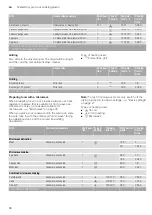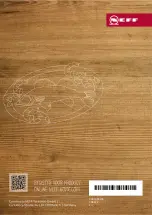
Tested for you in our cooking studio
en
45
Roasting and stewing in cookware
Only use cookware which is suitable for use in an oven.
Check whether the cookware fits in the cooking
compartment.
Glass cookware is most suitable. Place hot glass
cookware onto a dry mat after cooking. If the surface is
damp or cold, the glass may crack.
Shiny roasting dishes made from stainless steel or
aluminium reflect heat like a mirror and are therefore
not particularly suitable. The fish cooks more slowly and
browns less. Use a higher temperature and/or a longer
cooking time.
Observe the manufacturer's instructions for your
roasting cookware.
Uncovered cookware
To cook a whole fish, it is best to use a deep roasting
tin/dish. Place the tin/dish onto the wire rack. If you do
not have any suitable cookware, use the universal pan.
Covered cookware
When cooking with covered cookware, the cooking
compartment remains considerably cleaner. Ensure that
the lid fits well and closes properly. Place the cookware
onto the wire rack.
When stewing, add two to three tablespoons of liquid
and a little lemon juice or vinegar into the cookware.
Very hot steam may escape when opening the lid after
cooking. Lift the lid at the rear, so that the hot steam
can escape away from you.
Fish can also become crispy in a covered roasting dish.
Here, use a roasting dish with a glass lid and set a
higher temperature.
Steaming fish in the microwave
You can also steam fish in the microwave.
To do so, use enclosed cookware that is suitable for
microwave use or use a plate or microwave film to
cover the dish. Observe the notes on cookware suitable
for microwaves.
This will help retain the flavour and means you can use
salt and seasonings sparingly. If cooking fish whole,
add one to three tablespoons of water or lemon juice.
After cooking, leave the fish to rest for another 2-3
minutes to compensate for the temperature difference.
Take ready-to-eat meals out of the packaging. You can
cook more quickly and evenly using cookware which is
suitable for use in microwaves.
Recommended setting values
You can find the ideal heating type for your fish dishes
in the table. The temperature and cooking time depend
on the amount, composition and temperature of the
food. Settings ranges are indicated for this reason. Try
using lower setting values first. You can use a higher
setting next time if necessary.
The setting values are based on the assumption that
chilled fish is placed into a cold cooking compartment.
By doing so, you can make energy savings of up to 20
per cent. If you preheat the oven, you can reduce the
indicated cooking times by several minutes.
In the table, you can find information for fish with default
values for the weight. If you want to cook a heavier fish,
you should definitely use the lower temperature. If
cooking several fish, you should use the weight of the
heaviest fish as a reference for determining the cooking
time. The individual fish should be approximately the
same size.
As a general rule: the larger a fish, the lower the
cooking temperature and the longer the cooking time.
Turn any fish which is not in swimming position after
approx.
^
to
Z
of the indicated time.
Note:
Only use greaseproof paper that is suitable for
the selected temperature. Always cut greaseproof
paper to size.
Remove unused accessories from the cooking
compartment. This will achieve the best possible
cooking results and energy savings of up to 20 per
cent.
Types of heating used:
■
‡
Circo-roasting
■
„
Circotherm intensive
■
ˆ
Full-surface grill
■
•
Microwave
Dish
Accessories/cookware
Shelf posi-
tion
Type of
heating
Tempera-
ture in °C
MW power in
watts
Cooking
time in
mins.
Fish
Fish, grilled, whole 300 g, e.g. trout
Cookware, uncovered
1
‡
170-190
-
20-30
Fish, grilled, whole 300 g, e.g. trout
Wire rack
2
ˆ
250
90
15-20
Fish, braised, whole 300 g, e.g. trout Cookware, covered
1
•
-
600
3
360
2-7
Fish, grilled, whole 1.5 kg,
e.g. salmon
Cookware, uncovered
1
‡
170-190
-
30-40
Fish, braised, whole 1.5 kg, e.g.
salmon
Cookware, covered
1
•
-
600
10
360
10-15
* Preheat
** Slide the universal pan in underneath at shelf position 1
*** Turn during cooking


















